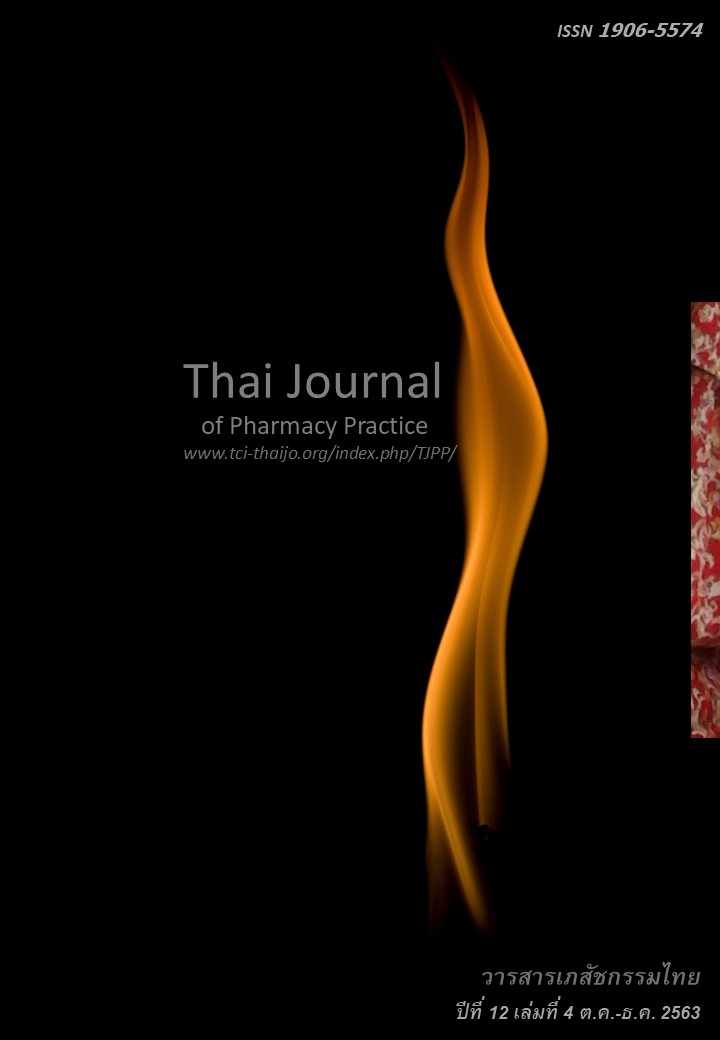การบริบาลทางเภสัชกรรมต่อผู้ป่วยโรคอารมณ์สองขั้วที่ได้รับการรักษาด้วยยาลาโมไตรจีน
Main Article Content
บทคัดย่อ
วัตถุประสงค์: เพื่อประเมินผลการบริบาลทางเภสัชกรรมในผู้ป่วยโรคอารมณ์สองขั้วที่ได้รับยาลาโมไตรจีน เป็นครั้งแรก วิธีการ: การวิจัยนี้เป็นการศึกษาเชิงทดลองที่คลินิกผู้ป่วยนอก โดยแบ่งกลุ่มตัวอย่างออกเป็นกลุ่มควบคุม 56 รายและกลุ่มทดลอง 61 ราย ด้วยวิธี block randomization กลุ่มควบคุมได้รับการบริการตามปกติ กลุ่มทดลองได้รับการบริบาลทางเภสัชกรรม ผู้วิจัยติดตามผู้ป่วยทั้ง 2 กลุ่มเมื่อผู้ป่วยมาพบแพทย์ในช่วงเวลา 8-12 สัปดาห์ ผลลัพธ์ของการศึกษา ได้แก่ การแพ้ยา จำนวนผู้ป่วยที่ได้รับยาเป็นไปตามแนวทางการใช้ยา จำนวนผู้ป่วยที่ให้ความร่วมมือในการใช้ยา และคะแนนความรู้ ผลการวิจัย: การศึกษาพบการแพ้ยาในกลุ่มควบคุม (ร้อยละ 17.9) ซึ่งมีแนวโน้มมากกว่ากลุ่มทดลอง (ร้อยละ 6.6) จำนวนผู้ป่วยที่ได้รับยาเป็นไปตามแนวทางการใช้ยาในกลุ่มควบคุม (ร้อยละ 57.1) น้อยกว่ากลุ่มทดลอง (ร้อยละ 88.5) (P<0.001) จำนวนผู้ป่วยที่ให้ความร่วมมือในการใช้ยาในกลุ่มควบคุม (ร้อยละ 58.9) มีแนวโน้มน้อยกว่ากลุ่มทดลอง (ร้อยละ 70.5) ความรู้ของผู้ป่วยเพิ่มขึ้นทั้ง 2 กลุ่ม (P<0.001) แต่พบว่ากลุ่มทดลองมีคะแนนความรู้เพิ่มขึ้น (4.9±2.8 คะแนน) มากกว่ากลุ่มควบคุม (1.8±2.8 คะแนน) (P<0.001) สรุป: การให้บริบาลทางเภสัชกรรมมีแนวโน้มลดความเสี่ยงการเกิดผื่นแพ้ยา เพิ่มจำนวนผู้ป่วยที่ได้รับยาลาโมไตรจีนเป็นไปตามแนวทางการใช้ยาและเพิ่มระดับคะแนนความรู้ รวมทั้งมีแนวโน้มการเพิ่มจำนวนผู้ป่วยที่ให้ความร่วมมือในการใช้ยา
Article Details
ผลการวิจัยและความคิดเห็นที่ปรากฏในบทความถือเป็นความคิดเห็นและอยู่ในความรับผิดชอบของผู้นิพนธ์ มิใช่ความเห็นหรือความรับผิดชอบของกองบรรณาธิการ หรือคณะเภสัชศาสตร์ มหาวิทยาลัยสงขลานครินทร์ ทั้งนี้ไม่รวมความผิดพลาดอันเกิดจากการพิมพ์ บทความที่ได้รับการเผยแพร่โดยวารสารเภสัชกรรมไทยถือเป็นสิทธิ์ของวารสารฯ
เอกสารอ้างอิง
Yatham LN, Kennedy SH, Parikh SV, Schaffer A, Bond DJ, Frey BN, et al. Canadian Network for Mood and Anxiety Treatments (CANMAT) and International Society for Bipolar Disorders (ISBD). 2018 guidelines for the management of patients with bipolar disorder. Bipolar Disord. 2018; 20: 97-170
Giri V, Giri O, Khan F, Kumar N, Kumar A, Haque A. Valproic acid versus lamotrigine as first-line monotherapy in newly diagnosed idiopathic generalized tonic-clonic seizures in adults - A randomized controlled trial. J Clin Diagn Res. 2016; 10: FC01-4.
Hurley S. Lamotrigine update and its use in mood disorders. Ann Pharmacother. 2002; 36: 860-73.
Botts S, Raskind J. Gabapentin and lamotrigine in bipolar disorder. Am J Health Syst Pharm. 1999; 56: 1939-44.
Willmore L, Messenheimer J. Adult experience with lamotrigine. J Child Neurol. 1997; 12 Suppl 1: S16-8.
Richens A. Safety of lamotrigine. Epilepsia. 1994; 35 Suppl 5: S37-40.
Betts T, Goodwin G, Withers R, Yuen A. Human safety of lamotrigine. Epilepsia. 1991; 32 Suppl 2: S17-21.
Biton V, Shneker B, Naritoku D, Hammer A, Vuong A, Caldwell P, et al. Long-term tolerability and safety of lamotrigine extended-release: pooled analysis of three clinical trials. Clin Drug Investig. 2013; 33: 359-64.
Faught E, Morris G, Jacobson M, French J, Harden C, Montouris G, et al. Adding lamotrigine to valproate: incidence of rash and other adverse effects. Epilepsia. 1999; 40: 1135-40.
Watanabe Y, Hongo S. Long-term efficacy and safety of lamotrigine for all types of bipolar disorder. Neuropsychiatr Dis Treat. 2017; 13: 843-54.
Kaur S, Dogra A. Toxic epidermal necrolysis due to concomitant use of lamotrigine and valproic acid. Indian J Dermatol. 2013; 58: 406.
Guberman A, Besag F, Brodie M, Dooley J, Duchowny M, Pellock J, et al. Lamotrigine-associated rash: risk/benefit considerations in adults and children. Epilepsia. 1999; 40: 985-91.
GlaxoSmithKline. NC: Highlights of prescribing information: The GSK group of companies [online]. 2016 [cited Nov 7, 2017]. Available from: www.gsksource.com/pharma/content/dam/GlaxoSmithKline/US/en/Prescribing_Information/Lamictal/pdf/LAMICTAL-PI-MG. PDF.
Ketter TA, Greist JH, Graham JA, Roberts JN, Thompson TR, Nanry KP. The effect of dermatologic precautions on the incidence of rash with addition of lamotrigine in the treatment of bipolar I disorder: a randomized trial. J Clin Psychiatry. 2006; 67: 400-6.
Wong I, Mawer G, Sander J. Factors influencing the incidence of lamotrigine-related skin rash. Ann Pharmacother. 1999; 30: 1037-42.
Bell JS, Rosen A, Aslani P, Whitehead P, Chen TF. Developing the role of pharmacists as members of community mental health teams: perspectives of pharmacists and mental health professionals. Res Social Adm Pharm. 2007; 3: 392-409.
Cipolle RJ, Strand L, Morley P. Pharmaceutical care practice: the patient centered approach to medication management services. 3rd ed. New York: McGraw-Hill; 2012.
Nicholas J. Pharmacist scope of practice. Ann Intern Med. 2002; 136: 79-85.
Aiken CB, Orr C. Rechallenge with lamotrigine after a rash: a prospective case series and review of the literature. Psychiatry (Edgmont). 2010; 7: 27-32.
Yasui-Furukori N, Hashimoto K, Tsuruga K, Nakamura K. Comorbidity of Stevens-Johnson syndrome and neutropenia associated with lamotrigine: a case report. Gen Hosp Psychiatry. 2014; 36: 761 e9-11.
Man CB, Kwan P, Baum L, Yu E, Lau KM, Cheng AS, et al. Association between HLA-B*1502 allele and antiepileptic drug-induced cutaneous reactions in Han Chinese. Epilepsia. 2007; 48: 1015-8.
Wang XQ, Lv B, Wang HF, Zhang X, Yu SY, Huang XS, et al. Lamotrigine induced DIHS/DRESS: Manifestations, treatment, and outcome in 57 patients. Clin Neurol Neurosurg. 2015; 138: 1-7.
Steiner TJ, Findley LJ, Yuen AW. Lamotrigine versus placebo in the prophylaxis of migraine with and without aura. Cephalalgia. 1997; 17: 109-12.
Terao T, Ishida A, Kimura T, Yoshida M, Hara T. Assessment of safety and efficacy of lamotrigine over the course of 1-year observation in Japanese patients with bipolar disorder: post-marketing surveillance study report. Neuropsychiatr Dis Treat. 2017; 13: 1441-8.
Mishara A, Krishna G.S., Alla S, Kurian TD, Kurian J, Ramesh M, et al. Impact of pharmacist-psychiatrist collaborative patient education on medication adherence and quality of life of bipolar affective disorder patients. Front Pharmacol. 2017; 8.
Kupapan T, Chusakul T, Kanjanasilp J, Sutthiruksa S. Increasing drug adherence by using multimedia and pharmaceutical care for patients with major depressive disorder [independent study]. Mahasara kham: Mahasarakham University; 2014
Aljumah K, Hassali MA. Impact of pharmacist intervention on adherence and measurable patient outcomes among depressed patients: a randomised controlled study. BMC Psychiatry. 2015; 15: 219.
Anderson GD. Children versus adults: pharmacokinetic and adverse-effect differences. Epilepsia. 2002; 43 Suppl 3: 53-9.
Shannon JD, Benjamin W. Bipolar disorder. In: Joseph TD, Robert LT, Gary CY, Gary RM, Barbara GW, editors. Pharmacotherapy: A phathophysio logic approach. 7th ed. New York: McGraw-Hill Medical; 2008. p. 1141-60.
Calabrese JR, Bowden CL, Sachs GS, Ascher JA, Monaghan E, Rudd GD. A double-blind placebo-controlled study of lamotrigine monotherapy in outpatients with bipolar I depression. Lamictal 602 Study Group. J Clin Psychiatry. 1999; 60: 79-88.
Kikkawa A, Kitamura Y, Aiba T, Hiraki K, Sendo T. Correlation between the efficacy of lamotrigine and the serum lamotrigine level during the remission phase of acute bipolar ii depression: a naturalistic and unblinded prospective pilot study. Biol Pharm Bull. 2017; 40: 413-8.
Department of Mental Health. Annual Report [online]. 2010 [cited Jul 22, 2019]. Available from: dmh.go.th/download/Ebooks/rpt53.pdf
Phongto K, Lueboonthavatchaail O. Effect of the resilience enhancement programe on suicidal ideation in suicidal attempter. Journal of Psychiatric Nursing and Mental Health. 2014; 28: 121-32.


